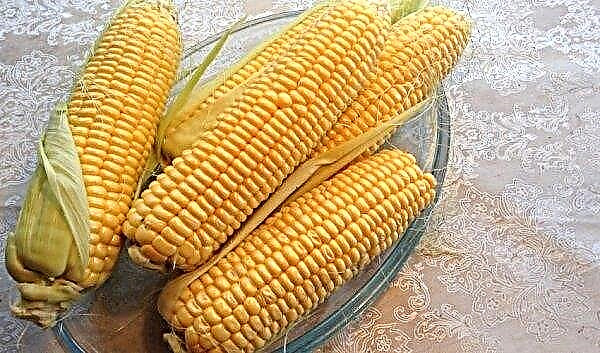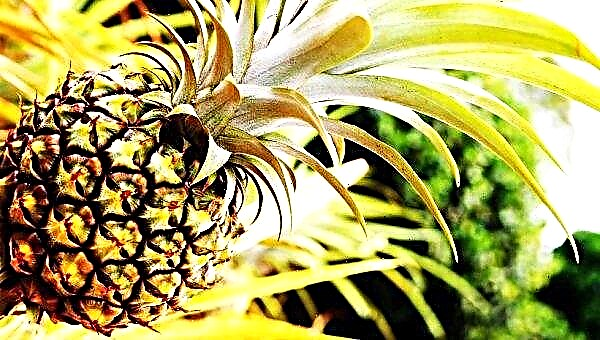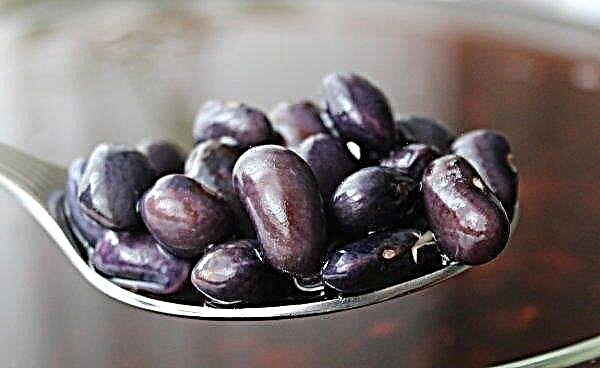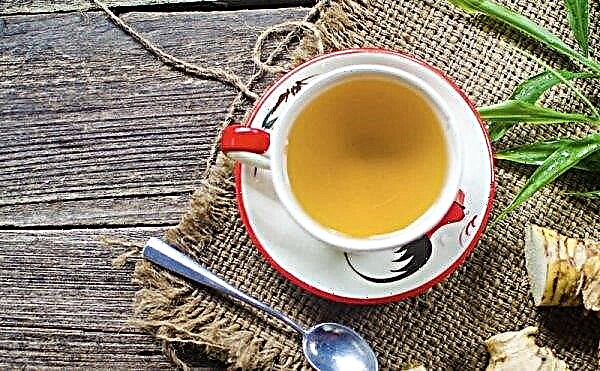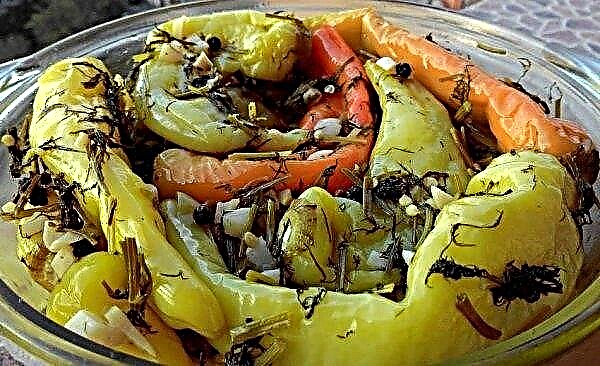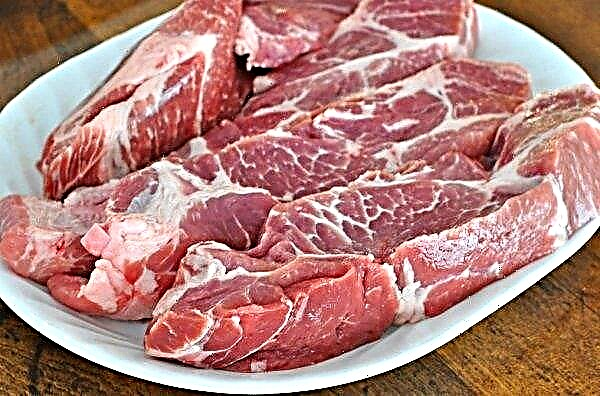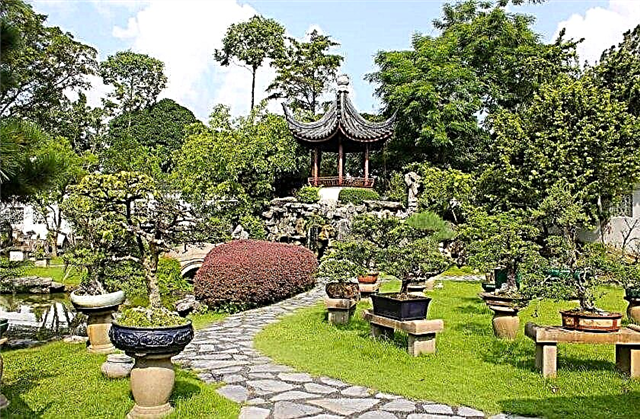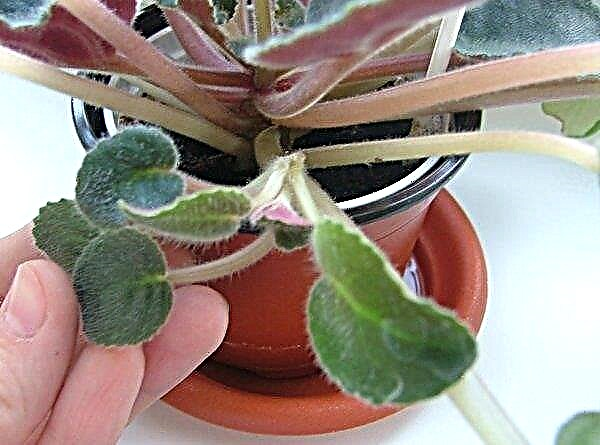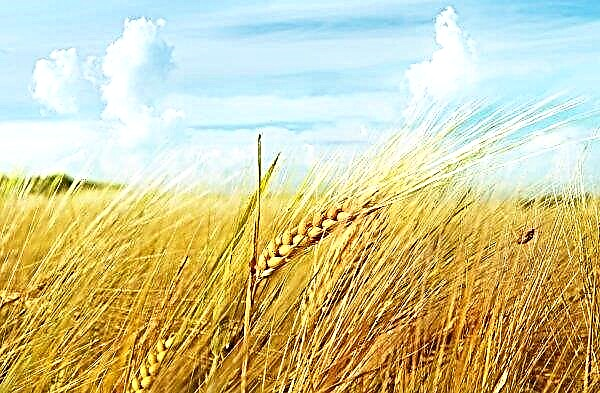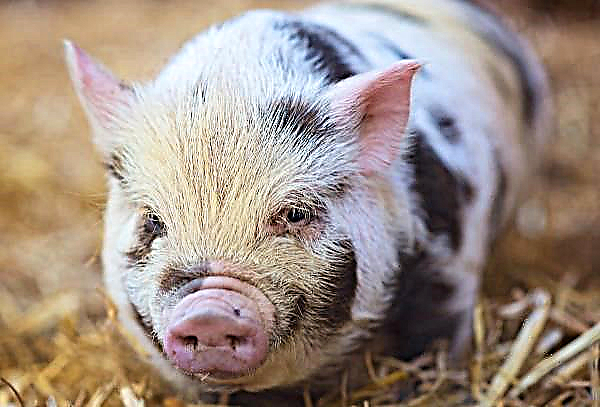At the end of the 19th century, the famous scientist, breeder Ivan Michurin developed a productive apple variety called Slavyanka. What he was interested in gardeners, and why he is still popular - in more detail later in the article.
Description and characteristic
The fruits and tree of Slavyanka are similar to the parental varieties: the appearance is like Antonovka, and from Renet the pineapple variety took on palatability.
Did you know? The ancient Germans believed that lightning did not touch the apple tree, since it has a divine origin, therefore they surrounded their homes with these trees.
Tree sizes
Apple-tree Slavyanka grows up to 3.5 m in height, flexible branches form a crown in the shape of a ball. Shoots do not grow densely, they are even, covered with gray-brown smooth bark. Light green oval foliage, medium sized plates.
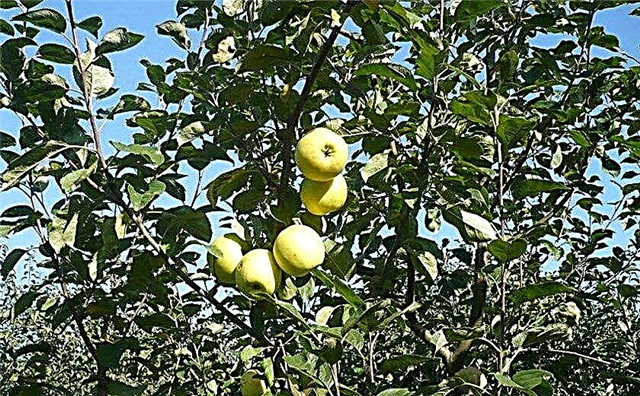 The flowers are frost-resistant, therefore, the ovaries form, even if the apple tree in bloom has found a strong spring frost to -5 degrees
The flowers are frost-resistant, therefore, the ovaries form, even if the apple tree in bloom has found a strong spring frost to -5 degrees
The timing of flowering and fruit ripening
The apple tree is covered with a cap of white inflorescences in early or mid-May, depending on the region. Since the variety is winter and intended for storage, fruits in technical ripeness are harvested in September. Until November-December, the fruits fully ripen and are ready for sale and consumption.
Fruits are rounded flattened, green-yellow in color, fully ripening, acquire more yellow color. Fruits are not large - up to 100 g, aromatic, sweetness and acid in taste balance each other. Thick peel allows you to transport fruit over long distances without losing its presentation.
Winter apple varieties also include:
Productivity and Pollinators
The first fruits can be harvested on the 4th – 5th year after planting, and a stable harvest - on the 6th year. An adult apple tree gives up to 200 kg of fruit. One of the characteristics of Slavyanka is self-fertility., i.e., it is pollinated without the presence of other apple trees and pollinating insects. In addition, in this process, weather conditions do not interfere with her.
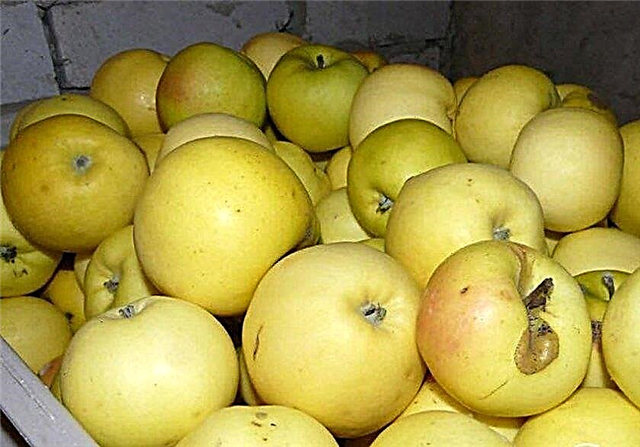 Slavyanka has delicious sweet fruits
Slavyanka has delicious sweet fruits
Winter hardiness
The winter variety bears fruit well throughout the Russian Federation, including the northern regions. The variety has excellent ability to recover from return frosts. Inflorescences are able to withstand temperatures of -5 ° C without flying around. In winter, the bark demonstrates resistance to cracking on frosty days, in general, the tree undergoes sub-zero temperatures up to -35 ° С.
Did you know? Apple’s personal computer line was named the Macintosh in honor of a variety of apples of Canadian origin, and in continuation of the apple theme in the name of the corporation itself.
Disease resistance
The variety shows excellent resistance to scab and vertebral rot, medium - to other diseases of a fungal nature. Double spring prophylactic treatments with copper-containing preparations will strengthen the protective properties of the apple tree.
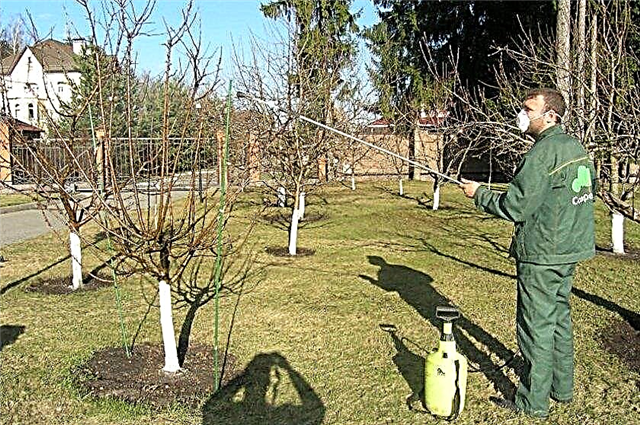 Slavyanka - a disease resistant variety
Slavyanka - a disease resistant variety
Landing and care
Slav from those crops that are unpretentious to the conditions of cultivation and care. It is wind and drought resistant.
The timing
The date of planting depends on the region in which it is made:
- in areas with a long winter period, the procedure is carried out in the fall (September-October);
- in areas with early spring planted in April.
Video: Apple tree planting instructions
Scheme and landing rules
When choosing a place to land, you need to consider several points:
- lighting - most of the day;
- groundwater - below 1.5 m from the surface of the earth;
- soil acidity - neutral or slightly acidic.
The composition of the soil does not play a big role, the apple tree bears fruit equally well on fertile, humus-rich soils and on sandy soils. In any case, the necessary nutrients mixed with 5 liters of soil are laid at the bottom of the planting hole:
- humus (4 kg);
- potassium salt (100 g);
- superphosphate (200 g).
Important! It is advisable to purchase seedlings before planting, with a closed root system and sleeping "eyes".
A hole for a seedling is prepared with dimensions of 80 × 100 cm. Landing technology:
- Sprinkle with fertilizers laid at the bottom of the soil, forming a hill 30 cm high.
- Set the reference stake, place the plant on the embankment, spread the roots.
- Fill the roots with soil, tamping the soil so that there are no voids.
- The growth point of the apple tree should remain 10 cm above the edge of the pit.
- Around the trunk, at a distance of half a meter, dig a furrow for irrigation, pour a seedling of 20 liters of water, tie it to a peg.
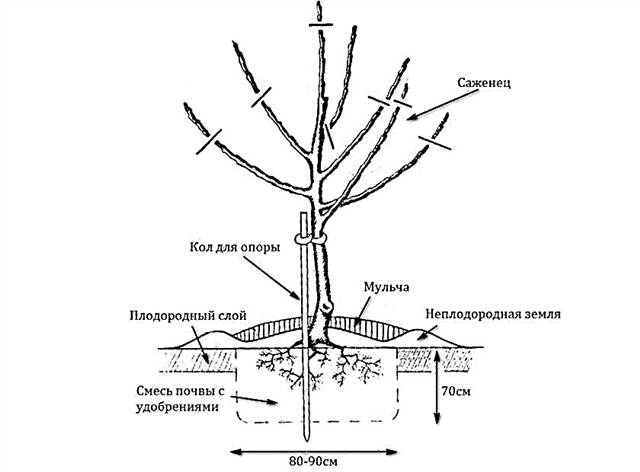
Watering and fertilizing
When planting around a tree trunk, an irrigation ditch should be dug. Humidification of the soil for a newly planted plant is carried out once a week in the morning or in the evening in an amount of 10 liters. Mulch after watering will inhibit the drying of the soil and the growth of weeds.
As the apple tree grows, the interval between irrigation decreases, and the water norm increases. An adult plant 5-6 years old is watered 4 times per season:
- 2 weeks before flowering;
- after flowering;
- two weeks before harvesting;
- after harvest, before wintering.
Important! First 2–3 years after planting, it is not necessary to fertilize the apple tree, it has enough nutrition laid in the hole.
The further fertilizer application sequence is as follows:
- April - root dressing 300 g of urea per 10 l of water;
- May (before and after flowering) - top dressing with a solution containing wood ash (200 g) and urea (60 g) per 10 l of water;
- end of July - apply wood ash to the soil (500 g / 1 m²);
- October (for digging) - distribute 4 kg of humus, 200 g of potassium salt, 300 g of superphosphate in the near-stem circle.
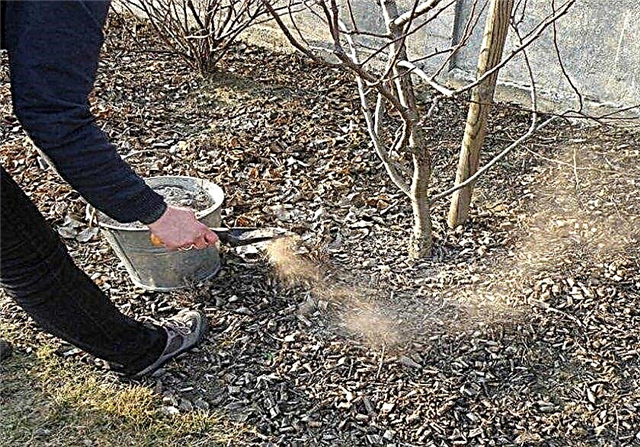
Cropping and shaping the crown
Slavyanka does not require frequent pruning: its shoots do not grow densely and at medium speed. The first procedure is needed to form the crown the next year after planting. Leave one central trunk, carving competitive, if any.
In the second year, the side shoots are shortened by a third of the length for the formation of the frame. Skeletal branches should be located at an acute angle relative to the trunk. All curves intertwined or growing inside the crown of the branch are cut.
The fruiting tree needs load balancing and rejuvenation of fruiting shoots. To do this, sanitary pruning of all damaged and unpromising branches is carried out. Lateral shoots of frame branches are normalized, leaving the strongest with the right direction of growth. The upper branches are cut to the length of the side shoots, restraining growth. The crown is thinned annually so as not to create conditions for the development of fungi.
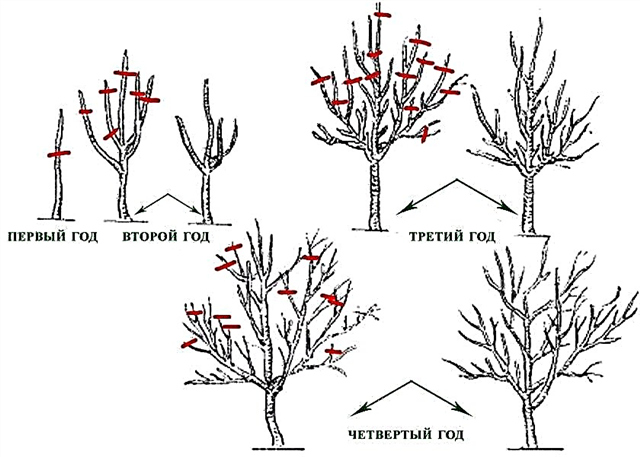 Pruning is not particularly difficult, because the branches are sparse, the main ones are upright, the growth rate is medium
Pruning is not particularly difficult, because the branches are sparse, the main ones are upright, the growth rate is medium
Harvesting and storage
Harvest Slavyanka harvested in late September, in the northern regions - in October. Remove the fruit with the stalk. Fruits harvested without a peduncle will not be stored for a long time, since the place of separation is the path for the penetration of fungi. Dry, undamaged fruits are sent to the bookmark. Fruits are laid out in a wooden container, layering with wax paper, stalk up. If they are folded in two layers, then the stem of the lower row is turned to the side.
Storage conditions:- the room is dry, dark, ventilated;
- temperature - 0 ... + 2 ° С;
- humidity - 80–85%.
Stocks should be inspected regularly, removing soft specimens, with suspicious spots.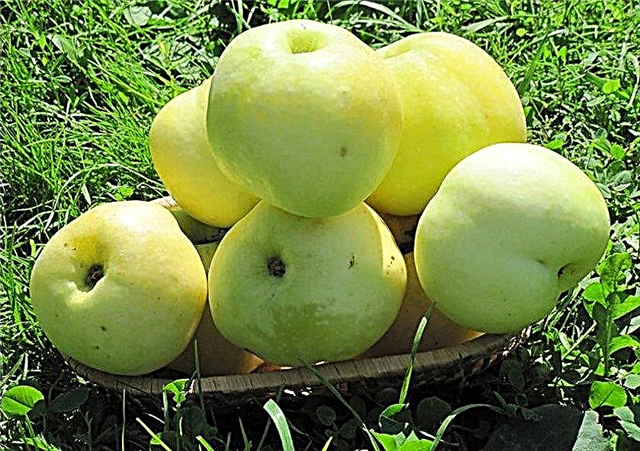
Slav is loved not only for the ease of cultivation and care, but also for the excellent taste and universal use of fruits. These fruits are good both in fresh form and in various winter preparations.

